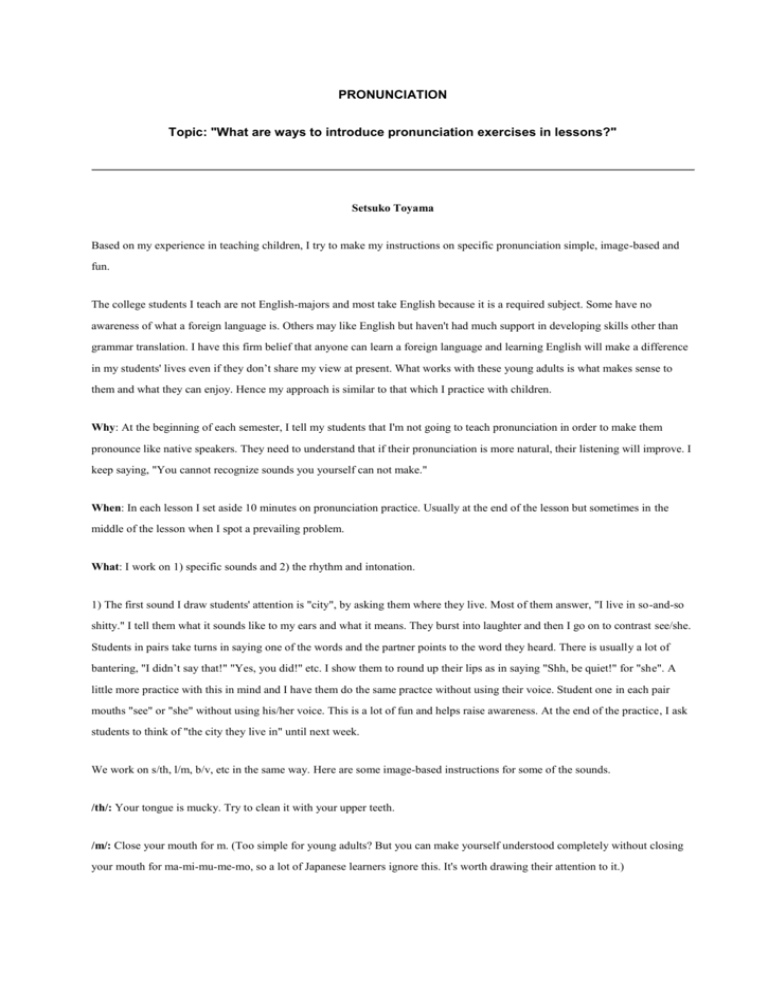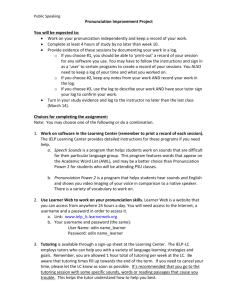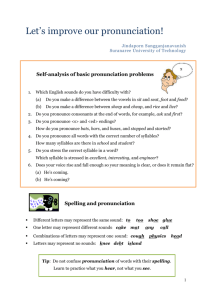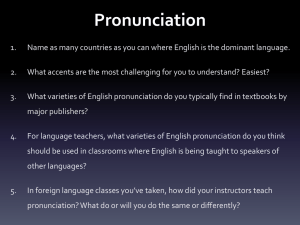PRONUNCIATION
advertisement

PRONUNCIATION Topic: "What are ways to introduce pronunciation exercises in lessons?" Setsuko Toyama Based on my experience in teaching children, I try to make my instructions on specific pronunciation simple, image-based and fun. The college students I teach are not English-majors and most take English because it is a required subject. Some have no awareness of what a foreign language is. Others may like English but haven't had much support in developing skills other than grammar translation. I have this firm belief that anyone can learn a foreign language and learning English will make a difference in my students' lives even if they don’t share my view at present. What works with these young adults is what makes sense to them and what they can enjoy. Hence my approach is similar to that which I practice with children. Why: At the beginning of each semester, I tell my students that I'm not going to teach pronunciation in order to make them pronounce like native speakers. They need to understand that if their pronunciation is more natural, their listening will improve. I keep saying, "You cannot recognize sounds you yourself can not make." When: In each lesson I set aside 10 minutes on pronunciation practice. Usually at the end of the lesson but sometimes in the middle of the lesson when I spot a prevailing problem. What: I work on 1) specific sounds and 2) the rhythm and intonation. 1) The first sound I draw students' attention is "city", by asking them where they live. Most of them answer, "I live in so-and-so shitty." I tell them what it sounds like to my ears and what it means. They burst into laughter and then I go on to contrast see/she. Students in pairs take turns in saying one of the words and the partner points to the word they heard. There is usually a lot of bantering, "I didn’t say that!" "Yes, you did!" etc. I show them to round up their lips as in saying "Shh, be quiet!" for "she". A little more practice with this in mind and I have them do the same practce without using their voice. Student one in each pair mouths "see" or "she" without using his/her voice. This is a lot of fun and helps raise awareness. At the end of the practice, I ask students to think of "the city they live in" until next week. We work on s/th, l/m, b/v, etc in the same way. Here are some image-based instructions for some of the sounds. /th/: Your tongue is mucky. Try to clean it with your upper teeth. /m/: Close your mouth for m. (Too simple for young adults? But you can make yourself understood completely without closing your mouth for ma-mi-mu-me-mo, so a lot of Japanese learners ignore this. It's worth drawing their attention to it.) /l/: You have eaten yakisoba. You have something stuck behind your upper teeth. Try to get it. 2) After the introduction of dialogs or target structures, I choose a sentence and challenge students to say it as fast as possible. This forces them not to pause between words. (I think our students have been trained to read the space between words!) Then they have to link sounds and drop sounds. Then we work on stress with the following two rlues. a) Stress the message words. This is simple enough and students can figure out the system. b) Go light on yucky grammar words. For example, don't say "four" for "for or "two" for "to." Using chants is a great way to practice if the students are musical, and most of them are. I bring in taped chants and play one while students tap their desks on the beat. The second time I have them point to the words on the beat. The third time I challenge them to chant with the tape. You can also improvise your own chants. Establish 1-2-3-4 rhythm by tapping, clapping or snapping your fingers and practice target language by saying the stressed words on the beat. You can pick up any of Carolyn Graham's Jazz Chants textbooks to find out more about chants. You'll find Small Talk or Grammarchants most helpful in college classes. Carolyn has also written one resource book, Singing, Chanting, Telling Tales, which has helped me so much in creating my own chants. Finally, there is one fun activity I learned from my pronuncitation teacher, Benay Lappe, years ago. Show the following 6 sentences. Challenge your students to say each one in the same length of time. Dogs eat bones. A dog eats a bone. The dog eats the bone. The dog will eat the bone. The dog has eaten the bone. The dog will have eaten the bone. I know your students will have fun doing this and learn a lot. Try it, and you'll have fun, too.





